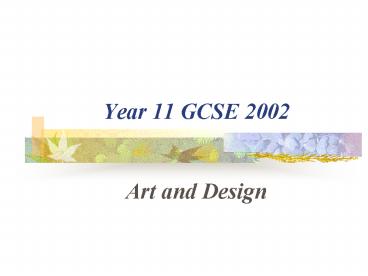Year 11 GCSE 2002 - PowerPoint PPT Presentation
1 / 28
Title:
Year 11 GCSE 2002
Description:
Vase of Flowers, c. 1660. Gardening and the breeding of beautiful flowers satisfied the Dutch interest in ... Many of these blossoms have meanings. ... – PowerPoint PPT presentation
Number of Views:63
Avg rating:3.0/5.0
Title: Year 11 GCSE 2002
1
Year 11 GCSE 2002
- Art and Design
2
Everyday objects
- Spanish school of painting
- Dutch school of painting
Use objects to express a personal message
3
Spanish School
Juan van der Hamen y LeónStill Life with Sweets
and Pottery, 1627
4
Spanish School
Juan Sánchez Cotán Quince, Cabbage, Melon and
Cucumber.
5
Spanish School
Francisco de Palacios
6
Spanish School
7
Dutch School
Willem Claesz. HedaDutch, 1593/1594 -
1680Banquet Piece with Mince Pie, 1635
Heda's largest known painting appears, at first
sight, seems to show a big meal. Yet plates and
knives are falling over the table's edge, while
glasses have already fallen over. From the 1620s
to the late 1640s, Dutch artists preferred a
monochrome style for their still lifes and
landscapes. Heda was a master of cool grey or
warm tan colour schemes. Later in the mid 1600s,
brighter colours would be part of the classical
period of Dutch painting.
8
Dutch School
Gardening and the breeding of beautiful flowers
satisfied the Dutch interest in art and in
science. Exotic flowers also indicated their
far-flung explorations and their expertise in
botany. In fact, a "tulip-mania" swept Holland
soon after tulips were imported from Turkey in
the 1550s. In 1637, Amsterdam's market in tulip
bulbs crashed, causing a depression. The
thirty-one species of plants in this vase cannot
bloom in the same season. Many of these blossoms
have meanings. The upper flowers thrive in the
sunshine that streams through De Heem's studio
windows to be reflected in the vase. The lower
plants, farther away from the light of heaven,
droop and wilt. Near the bottom, a salamander
stares hungrily at a spider, while a snail, moth,
and ants crawl on the marble shelf.
Jan Davidsz. de HeemDutch, 1606 -
1683/1684Vase of Flowers, c. 1660
9
Dutch School
Many Dutch still-life painters carefully arranged
foreground objects against neutral, blank
backgrounds. Similarly, the forest undergrowth
here is so dark it nearly conceals a stone
archway. The sea and the land are suggested by
the fishing rod, bait box, and catch of fish that
surround a wicker basket with fruit and
vegetables. The work shows the story of the
cycles of life. A nest of birds' eggs implies
birth. Full blossoms and ripe fruit suggest
maturity. The gnarled tree stump characterizes
old age. Ultimately, death appears with the fish
and, being eaten by ants, a lizard. The wheat and
grapes offer salvation by symbolizing Jesus'
blessing of bread and wine at the Last Supper.
Abraham MignonDutch, 1640 - 1679Still Life with
Fruit, Fish, and a Nest,
10
Others
11
(No Transcript)
12
Expressive work
- Gruenwald
- El Greco
- Munch
- Francis Bacon
- Jenny Saville
Strong colours, exaggerated lines and distorted
forms to express intense emotions
13
Expressive work
14
(No Transcript)
15
(No Transcript)
16
(No Transcript)
17
(No Transcript)
18
(No Transcript)
19
(No Transcript)
20
(No Transcript)
21
(No Transcript)
22
Others
23
(No Transcript)
24
Fantastic Landscapes
- Max Ernst
- Surrealists
- Make studies of the surface of objects that have
been corroded, withered etc
25
(No Transcript)
26
(No Transcript)
27
(No Transcript)
28
Others































